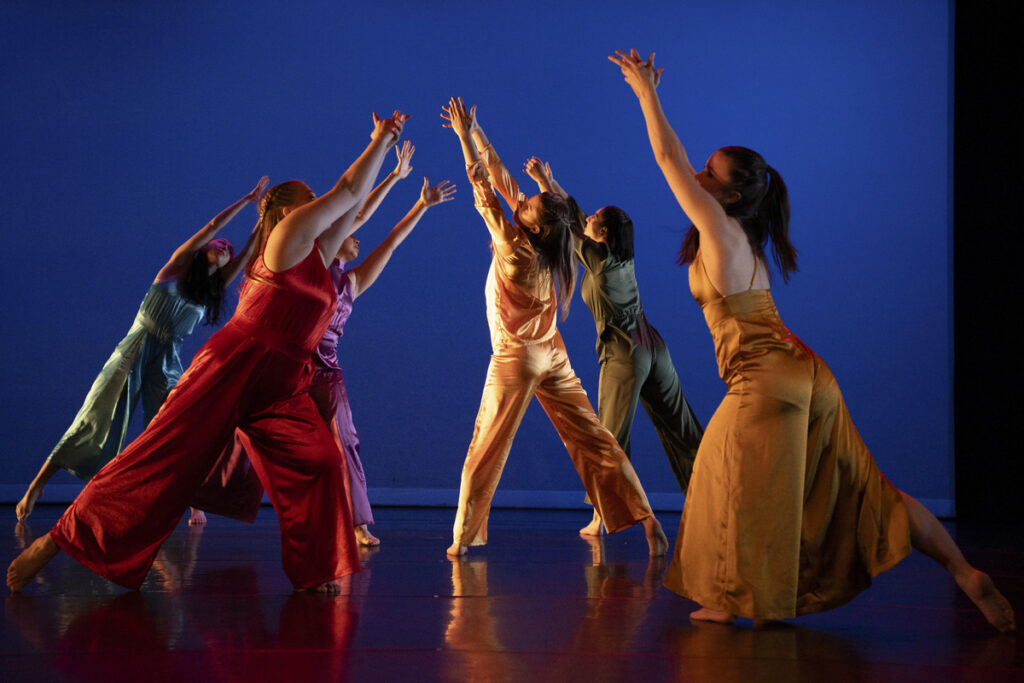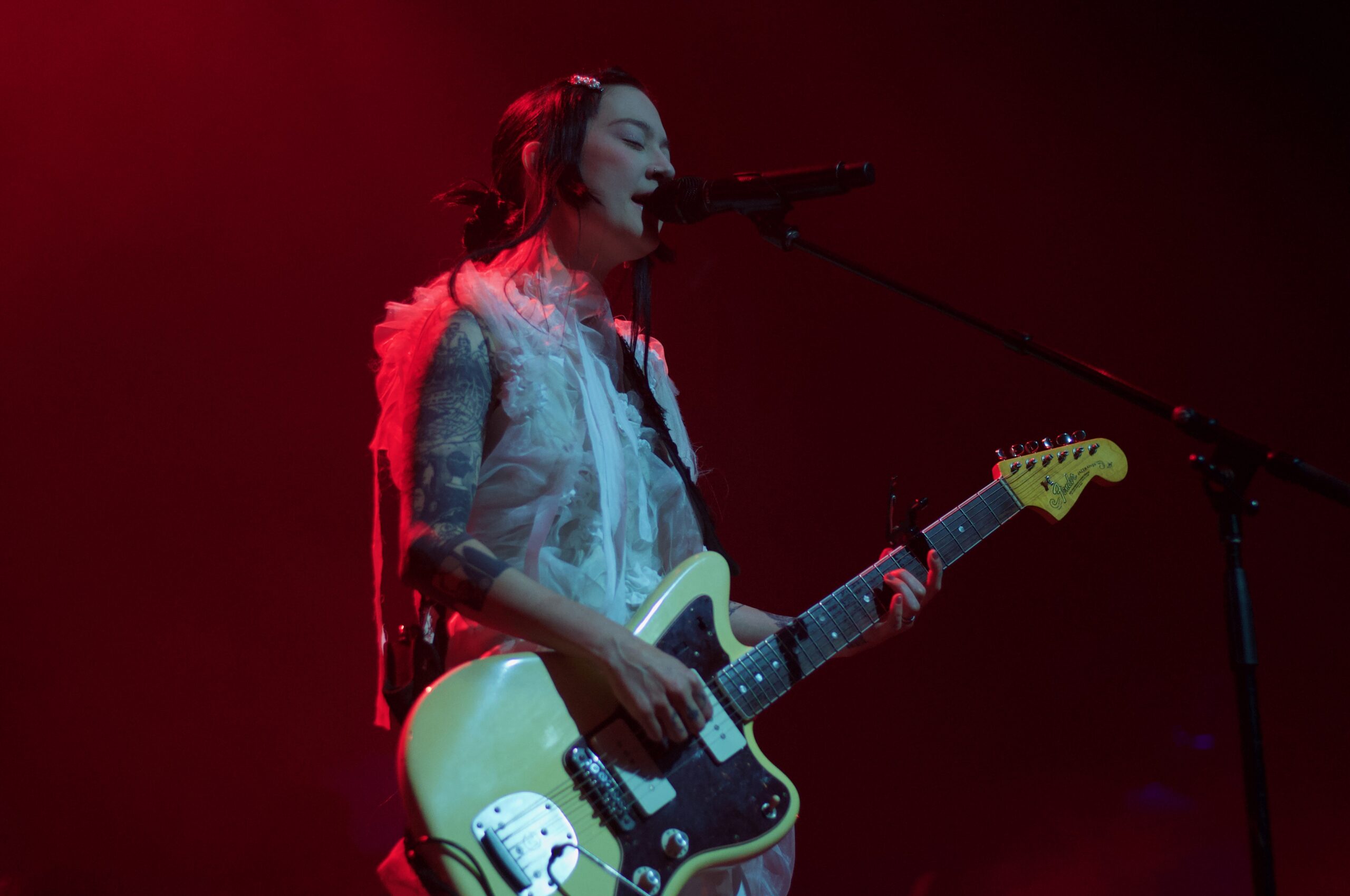Audience members find their own kinds of hope through the performances at the Loyola Dance Program’s fall show “Excavating Hope.”
The Loyola Dance Program’s fall show “Excavating Hope,” which premiered Nov. 16 at the Newhart Family Theatre, didn’t open with a dance. Instead, it opened with a call to action.
Taking center stage, the dance program’s creative director Sandra Kaufmann described the semester-long process and motivations behind the concert. After summarizing the various, distinctly styled dances in the program, many of which were narratives over the course of three separate songs, she implored the audience to engage with the show’s key theme — searching for hope through movement and imagination.
“We ask you to be brave,” Kaufmann said. “The quest of being brave enough to be hopeful is what we’re all seeking here.”
After Kaufmann’s preface, 11 dancers entered, assuming individualized poses while dressed in vibrant silk garments. Suddenly, one dancer raced through the audience onto the stage, dressed in bright red and holding an open umbrella.

A dialogue between the dancers began onstage, during which they defined “excavating” and “hope” for the audience. The skit felt disjointed and unnecessary, having followed Kaufmann’s comprehensive introduction.
However, the performers’ stiffness during the scene immediately dissipated the moment music started playing and the dancing began.
The opening number, “Visions of Hope/Journeys of Healing,” was a three-part narrative set to the songs Ryuichi Sakomot’s “Sounds of The Earth” and Pablo Nouvelle’s “Solfeggio Frequencies.” The piece was choreographed by Toranika Washington, a guest choreographer who specializes in post-modern explorative dance, according to Kaufmann.
The dance was inspired by the human body’s chakra system, which are “spinning disks of energies located in the body,” according to the show’s program. The music included a melodious piano, which prompted dancers to move in tandem with the notes.
The abstract, flowing arm sways and graceful turns of each dancer blended together despite their asynchronous movements. The number seemingly executed a kaleidoscope effect, emphasized by the glossy blouses and flowing pants of each dancer as they twirled around each other under muted stage lights.
As the dance continued, projections were shown on the screen at the back of the stage of feet walking across a fallen tree, a playground and a campfire by the ocean. At times, these distracted from the performance, working against the dancers’ thoughtful and interconnected movements.
The next piece was the program’s student-choreographed “Unstrung” by fourth-year Caroline Cady. This piece also worked in a narrative of three parts, staged to the songs “Guitar Piece,” “Turmoil and Tinfoil,” and “Pyramid Country” by Billy Strings. Each ensemble member represented a different facet of the lead dancer’s inner life, according to Kaufmann.
Dressed in white, sheet-like leotards wrapped in vines, the dancer’s costumes didn’t contribute to the storytelling. However, the staging itself demonstrated the distress of the protagonist and the interrelation of all the performers as they moved dynamically to the sound of a twangy guitar.
Cady’s choreography highlighted both the talent and joy of her dancers, giving each a short solo during the final segment of the piece. During these solos, the other dancers on stage cheered for their peers along with the audience.

The next piece in the show — “Tutu En L’air,” choreographed by dance instructor Raúl Díaz-Maroto Casasola — featured Cady herself. This campy, comely piece choreographed to Franz Liszt’s “Hungarian Rhapsody No. 2” stole the show, satirizing the performative drama of dance and emphasizing its capacity for growth, joy and hope.
The piece began with Cady — dressed in a tutu and pointe shoes — entering through the audience, dramatically displaying a platter of pointe shoes to the swelling music. The rest of the piece featured Cady gracefully teaching the shoeless ensemble how to dance, eventually awarding them pointe shoes and tutus of their own as they danced triumphantly in sync.
“Tutu En L’air” caused the audience to giggle at the sarcastically saccharine smiles and awkward movements of the ensemble as they mimed learning to dance en pointe. The choreography developed beautifully and the ability to find hope through learning to dance seemed to resonate with the performers, apparent through their joyous movements and genuine smiles.
After “Tutu En L’air,” the program took a sharp turn transitioning into “Chimera II” — choreographed to “The Wired World” by TB and “Nocturne No. 9 in B Major, Op. 32, No. 1” by Frédéric Chopin — by senior lecturer of dance Amy Wilkinson.
The piece, which featured five dancers with sleek hair dressed in black leather skirts, was an amalgamation of different artistic styles meant to represent the physicality of anger, according to Kaufmann.
The dancers masterfully executed the choreography of the piece, alternating between sharp, dynamic poses and languid movements reminiscent of taking a deep breath. True to the piece’s title, the dancers worked jointly to convey the illusion of one complete emotional being, each individual becoming a reflection of the others.
The performance ended with the piece choreographed by Kaufmann — “The Tale of Jonathan Livingston Seagull” based on the book “Jonathan Livingston Seagull” by Richard Bach. Staged to Eric Weissberg and Steve Mandell’s “Dueling Banjos,” Pink Floyd’s “The Great Gig in the Sky” and Engima’s “Return to Innocence,” Kaufmann said she created the piece because Jonathan’s story was influential to her childhood.

The piece followed the narrative of the book as Jonathan — played by third-year Neva Lang — tried to teach her fellow seagulls how to fly. The ensemble dancers of the piece committed to their roles as seagulls, embracing the awkward bird-like movements incorporated into the choreography.
Although Lang was exquisite in her role as Jonathan, third-year students Zoe Holland and Allison Kiewatt stole the show in their respective supporting roles. In both “The Tale of Jonathan Livingston Seagull” and “Tutu En L’air,” Holland’s emotive powers and Kiewatt’s graceful strength made these dancers impossible to look away from.
The performance ended with all of the dancers dressed in flowing white, standing hand-in-hand for their final bow. As the audience cheered, an overpour of pride and exultation donned each of their faces, indicating what dancing gives to them — hope.
Featured image courtesy of José Perez
-

Hailey Gates is a third-year student majoring in English and minoring in journalism and art history. In addition to working as Opinion Editor of The Phoenix, she is a Writing Fellow at the Writing Center and a Provost Fellow undergraduate researcher. She loves to write feature stories about local art and artists and Opinion pieces on everything from national politics to Reese’s Peanut Butter Pumpkins.
View all posts











